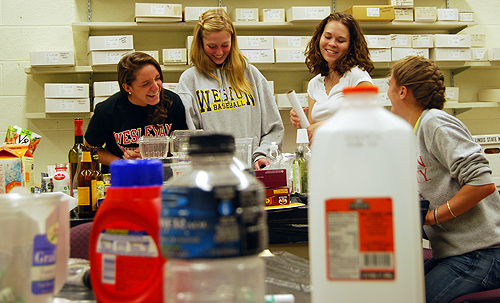Archeology Students Rummage though Rubbish For Lab Assignment

In Introduction to Archaeology, all students were trash-talking their first assignment.
Titled “Understanding Garbage – Research and Analysis,” the laboratory project helped students understand ways archeologists collect and analyze data by rummaging through rubbish and taking note of their findings.
“These people must party all the time,” says Rebecca Fonticoba ’12, who separated a dozen beer and alcohol bottles from a garbage sample on Sept. 30. “They’re obviously not drinking a lot of soda.”

The class’s 52 students worked in groups to dissect four garbage stations in an Exley Science Center classroom. Each station represented a week’s worth of garbage collected by a single household. The samples included food-related garbage and other materials, including personal care products and pantyhose.
“This lab introduces students to interpreting a community,” explains the course’s instructor, Sarah Croucher, assistant professor of anthropology, assistant professor of archaeology and assistant professor of feminist, gender and sexuality studies. “When the students go through the garbage, they are thinking, ‘what does this trash say about a particular household’s lifestyle?’ The study of contemporary garbage might seem strange for an archaeology class, but this has been a long-running study by archaeologists since the 1970s, which the class has been reading about.”
After taking extensive notes at each garbage “dump,” the classmates predicted who lived in the household, their economic and social status, ethnicity, demographics, among other topics.
While Fonticoba’s garbage sample consisted of drinks, cigarette butts and plastic party cups, students at a neighboring station discovered healthier alternatives.
“We have some Nature Valley nut granola bars. Six of them at 1.2 ounces each, Yoplait Kids yogurt drinks with 25 percent less sugar, Dannon Lite and Fit plain low-fat yogurt,” says Maggie Drowica ’12 to her classmate and group note taker Anna Crystal ’11.
“There’s also a receipt here from It’s Only Natural, the store, not the restaurant, for $14.11. All the items were 59 cents … nothing was more than a dollar,” says Jessica Steinke ’12.
Although the students collected data collaboratively, they individually wrote a concluding paper, noting their interpretations, data and conclusions. They developed achievable research goals, a research methodology and a critical analysis of the project with broader archaeological questions.
Juliana Shortell, archaeological collections manager; Rachel Miller-Howard ’10; and Thea De Armond ’09, course teaching apprentices assisted with the three-day project.
Following the lab, only a fraction of the lab’s garbage was rerouted to the dumpster.
“Part of the reading on garbology has emphasized the importance of recycling and we’ll be following those rules.” Croucher says.

